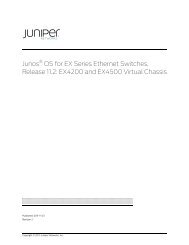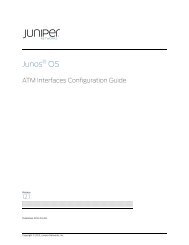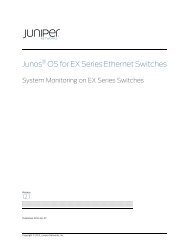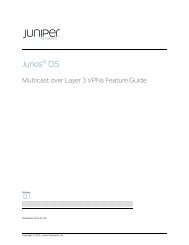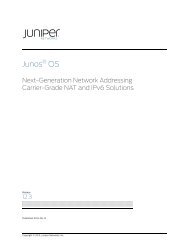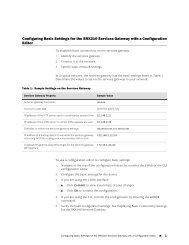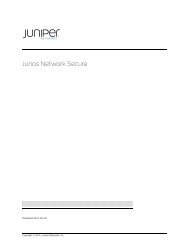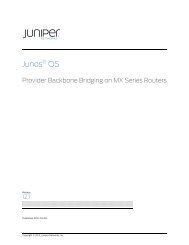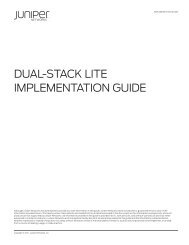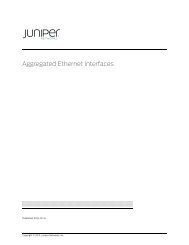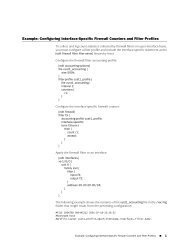Spanning Tree Protocol on Juniper Networks MX Series 3D ...
Spanning Tree Protocol on Juniper Networks MX Series 3D ...
Spanning Tree Protocol on Juniper Networks MX Series 3D ...
Create successful ePaper yourself
Turn your PDF publications into a flip-book with our unique Google optimized e-Paper software.
<str<strong>on</strong>g>Spanning</str<strong>on</strong>g> <str<strong>on</strong>g>Tree</str<strong>on</strong>g> <str<strong>on</strong>g>Protocol</str<strong>on</strong>g><br />
<strong>on</strong> <strong>Juniper</strong> <strong>Networks</strong> <strong>MX</strong> <strong>Series</strong> <strong>3D</strong> Universal Edge Routers<br />
When a bridge is first attached to a network segment, and before it can start forwarding<br />
data, it goes through a series of states while it processes BPDUs and learns the topology<br />
of the network. There are five states in STP, described in Table 1 <strong>on</strong> page 8.<br />
Table 1: STP States<br />
State<br />
Purpose<br />
Listening<br />
Processing BPDUs and building active topology<br />
Learning<br />
Building bridging tables; no forwarding of data<br />
Forwarding<br />
Sending and receiving data; normal operati<strong>on</strong><br />
Blocking<br />
A port that would cause a loop if it were sending data, so it is <strong>on</strong>ly receiving BPDUs, until<br />
a topology change removes the possibility of a loop<br />
Disabled<br />
A port that is manually isolated from the network<br />
Notes <strong>on</strong> the Listening State<br />
Initially, every bridge acts as if it is a root bridge, and enters the listening state to determine<br />
the active topology. An absence of BPDUs for a certain period of time can also cause the<br />
bridge to transiti<strong>on</strong> into the listening state. In the listening state, no user data is being<br />
passed; however, the port is sending and receiving BPDUs in an effort to determine the<br />
active topology. The three initial c<strong>on</strong>vergence steps take place in the listening state.<br />
During initial c<strong>on</strong>vergence, any ports that are not elected as a designated or root port go<br />
into the blocking state.<br />
After the default length of 15 sec<strong>on</strong>ds in the listening state, any ports that remain as<br />
designated or root ports progress into the learning state.<br />
Notes <strong>on</strong> the Learning State<br />
The learning state is a 15-sec<strong>on</strong>d interval during which the bridge does not pass user data<br />
frames while the bridge is building its bridging table. As the bridge receives frames, it<br />
places the source MAC address and port of each frame into the bridging table. The learning<br />
state reduces the amount of flooding required when data forwarding begins.<br />
At the end of the learning state, if a port is still a designated port or a root port, it transiti<strong>on</strong>s<br />
into the forwarding state. The port starts sending and receiving user data frames <strong>on</strong>ly<br />
after it enters the forwarding state.<br />
The bridge spends a default of 15 sec<strong>on</strong>ds in each of the listening and learning states.<br />
STP Timers<br />
The <str<strong>on</strong>g>Spanning</str<strong>on</strong>g> <str<strong>on</strong>g>Tree</str<strong>on</strong>g> <str<strong>on</strong>g>Protocol</str<strong>on</strong>g> is c<strong>on</strong>trolled by three timers, as shown in Table 6.<br />
8<br />
Copyright © 2013, <strong>Juniper</strong> <strong>Networks</strong>, Inc.



